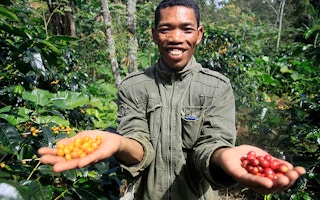For millions of people around the world, a cup of coffee is necessary to start the day. Though it might seem like the supply of this popular commodity is endless, climate change and a growing demand is likely to bring about dramatic changes to global coffee production in coming decades. Vietnam will be among the most affected coffee-growing countries if predictions of a 2-degree Celsius temperature rise by 2050 hold true, as huge areas that currently support coffee farms will no longer be able to do so.
Vietnam is the world’s largest producer of Coffea canephora, or Robusta coffee, which is mainly used to make instant coffee and other lower-quality products. According to Conservation International, the Southeast Asian nation accounts for more than 17 per cent of global coffee production, up from just 3 per cent in 1990.
This has been an economic boon for a huge number of people: 550,000 smallholder farmers supply over 95 per cent of Vietnam’s coffee, and another 500,000 people are engaged in seasonal work in the industry, according to the Center for Tropical Agriculture (CIAT) office in Hanoi.
However, Robusta coffee production in Vietnam is at a turning point, according to Peter Laderach, Senior Climate Change Specialist at CIAT. A devastating drought in the Central Highlands – the country’s primary coffee growing area – earlier this year will likely hurt annual harvest figures. Laderach asserts that such severe weather events, known as climate variability, will become more common in the future.
“The dry season is predicted to get longer, so those dry spells are becoming increasingly normal,” he said in an interview with Mongabay. “Patterns like El Nino will become more frequent.”
This year’s drought, in particular, will serve as a major wake-up call for the country, Laderach argues.
CIAT research shows that by 2050, the drought period for southern Vietnam, which includes the Central Highlands, may last until June, almost three months longer than usual. Meanwhile, precipitation in the highlands during these dry months could fall by as much as 20 mm, creating major problems for a part of the country where 90 per cent of water usage is related to coffee production.
“
One of our standards is that every cooperative has to have measures to reduce the greenhouse effect, so they are training producers in many ways to reduce deforestation, such as using coffee covers instead of wood to dry coffee.
Tran Ban Hung, associate for Vietnam, Fairtrade Asia and Pacific
“Coffee in the 21st Century”, a report released by Conservation International in April, shows that the impact of such changes in the climate will be dramatic. By 2050 the total suitable area for Robusta growth in Vietnam is predicted to fall from 32,558 sq. miles by almost half to 17,943 sq. miles. Meanwhile, widespread irrigation and fertilizer use could further deplete the Central Highlands of necessary nutrients for healthy soil.
As the climate changes, other parts of the region will actually become more suitable for coffee production. Yet many of these areas are currently forested. According to the report, by 2050 a full 20 per cent of suitable areas for Robusta coffee growth in Southeast Asia will overlap with areas that are currently protected.
Ensuring coffee production without destroying forests
While the situation may seem dire, experts say much can be done to improve the resiliency of Vietnam’s coffee crops by using forests and improved tree cover instead of cutting them down. Tran Ban Hung, Fairtrade Asia and Pacific’s Associate for Vietnam, explains that Fairtrade uses its standards to train coffee farmers in forest conservation. The organisation currently works with 15 coffee cooperatives in the country.
“One of our standards is that every cooperative has to have measures to reduce the greenhouse effect, so they are training producers in many ways to reduce deforestation, such as using coffee covers instead of wood to dry coffee,” he said. “They also invest premium money to buy and plant more shade trees for coffee gardens to reduce the use of water and improve the quality of coffee.”
Under the Fairtrade system, coffee is sold at a premium, which is returned to the cooperatives and invested in local communities.
The concept of providing shade for crops may sound simple, but it could play a major role in helping Vietnam’s coffee-growing areas adapt to rising temperatures while preventing the need for farmers to cut down forests for new production.
Another benefit of shade trees, explains Hung, is that they can help producers make more money.
“Farmers used to plant as many coffee trees as possible because it would bring in a lot of income, but through training they see that planting shade trees will help them improve the quality of the product,” he shares. “Some farmers start with shade trees like durian, which helps them get additional income.”
This story was published with permission from Mongabay.com. Read the full story.

















